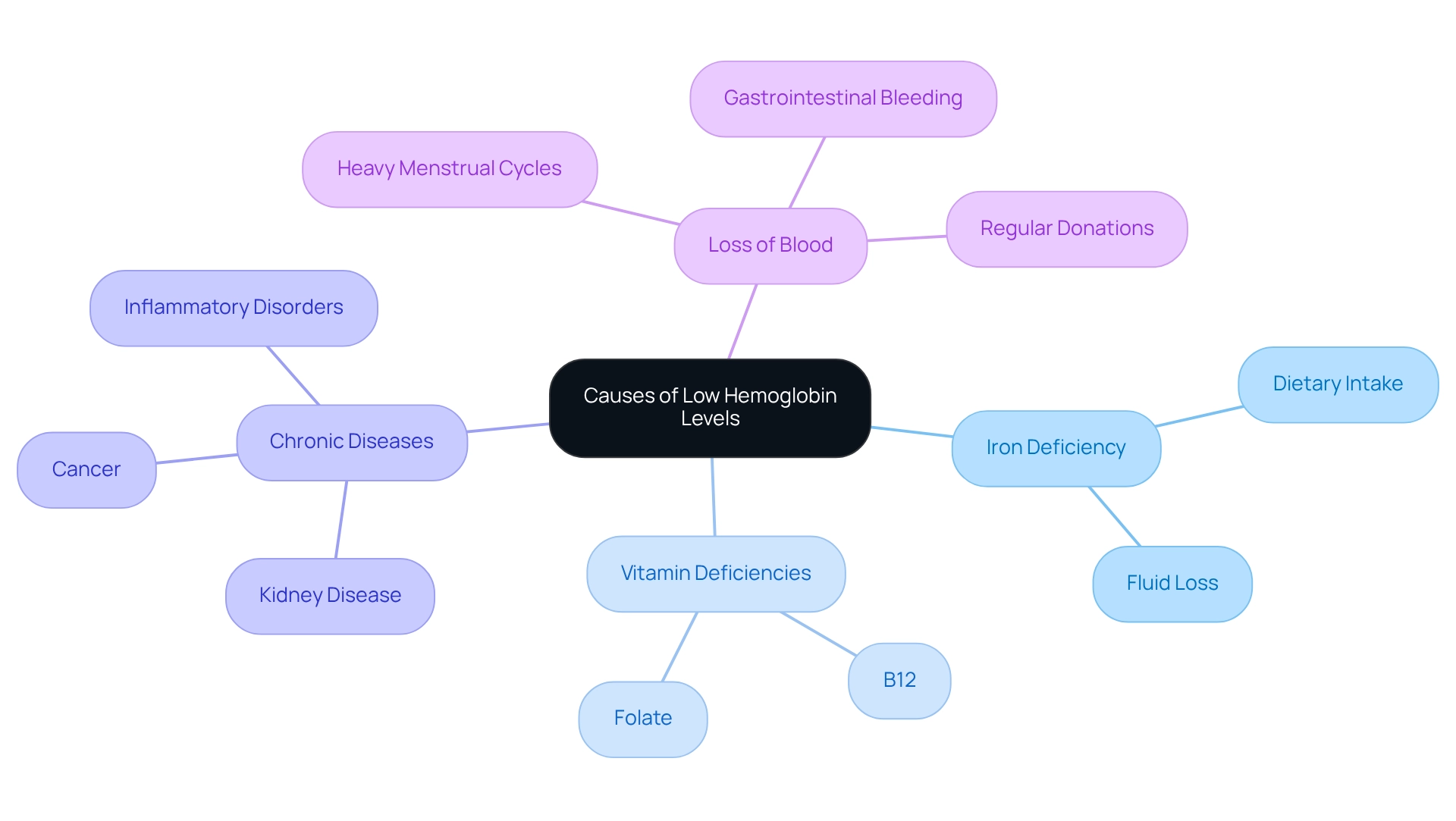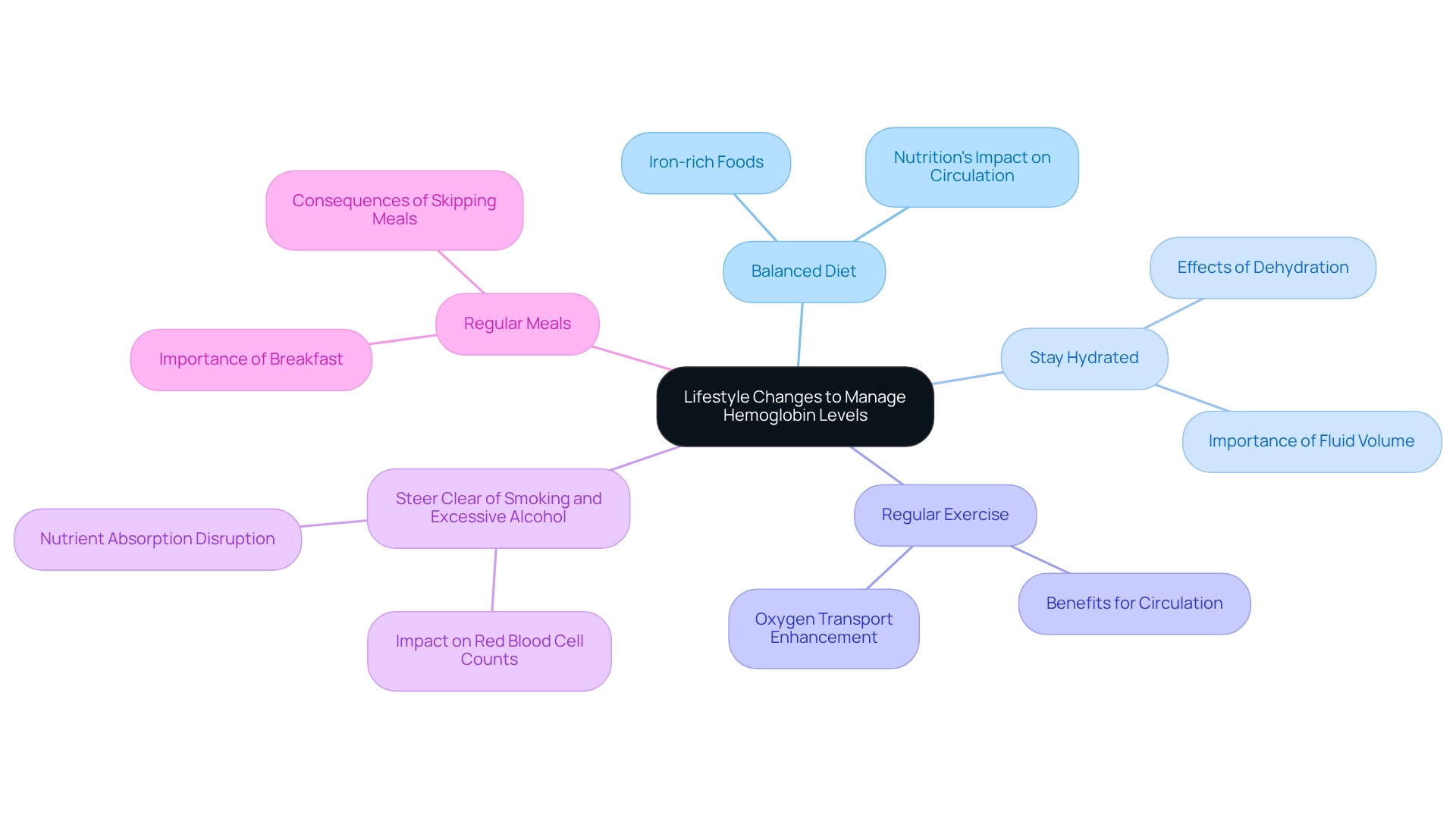Overview
If you’re looking to lower your hemoglobin levels effectively, it’s important to focus on dietary changes that can make a real difference. Consider increasing your intake of iron-rich foods and addressing any vitamin deficiencies you may have. It’s also essential to manage any underlying health conditions that could be contributing to your situation.
Understanding the causes of low hemoglobin and recognizing the symptoms can be overwhelming, but you’re not alone. Implementing lifestyle modifications, along with seeking professional support, is crucial for achieving healthier blood protein levels and enhancing your overall well-being. Remember, together, we can navigate this journey toward better health.
Take heart in knowing that small, positive changes can lead to significant improvements. We’re here for you, and with a compassionate approach, you can achieve your goals. Let’s embrace these changes together and work towards a healthier, happier you.
Introduction
In the intricate world of human health, hemoglobin plays a pivotal role, acting as the lifeblood of vitality and energy. This essential protein, found in red blood cells, is responsible for transporting oxygen from the lungs to every corner of the body while facilitating the removal of carbon dioxide. However, many individuals worldwide grapple with low hemoglobin levels, which can lead to conditions like anemia. These conditions often manifest as fatigue, weakness, and a reduced quality of life, leaving many feeling overwhelmed and concerned.
Recent statistics reveal that millions are affected, particularly vulnerable populations such as women and young children. This highlights the importance of understanding hemoglobin and its implications for our health. Together, we can navigate this challenge. This article delves into the causes, symptoms, diagnosis, and effective treatments for low hemoglobin levels. It emphasizes the importance of proactive health management and the integration of lifestyle changes to foster overall well-being. Remember, we’re here for you, and together, we can achieve your health goals.
Understanding Hemoglobin: The Key to Healthy Blood
Hemoglobin is a vital protein found in red blood cells, playing a key role in transporting oxygen from the lungs to tissues throughout the body. This essential protein also helps return carbon dioxide from the tissues back to the lungs for exhalation. Maintaining regular blood protein levels is crucial for sustaining energy and overall well-being.
When blood protein concentrations decrease, individuals may experience anemia, leading to symptoms such as fatigue, weakness, and a range of other health issues.
Recent studies indicate that a significant portion of the global population is affected by low blood iron, with anemia impacting approximately 30% of women and 40% of preschool children worldwide. This highlights the importance of monitoring blood protein levels, especially in vulnerable groups like expectant mothers, where the incidence can reach 46%. The World Health Organization (WHO) recognizes anemia as a pressing public health issue and is actively working to reduce its prevalence through initiatives like the Anaemia Action Alliance.
These efforts underscore the importance of understanding the role of hemoglobin not just in oxygen transport but also in overall well-being and energy levels.
At Minimal, we truly understand the importance of maintaining healthy blood protein levels as part of a holistic approach to wellness. Our weight loss programs, including Semaglutide, combined with personalized fitness training, nutrition advice, breathwork, and acupuncture, empower individuals to achieve lasting improvements in their well-being. Real-world experiences highlight the effects of low red blood cell levels on energy.
Those facing anemia often report diminished stamina and increased fatigue, which can significantly affect daily activities and quality of life. Insights from hematologists emphasize that maintaining proper blood protein levels is essential for optimal wellness, directly influencing energy production and overall vitality. As a consultant for CSL Vifor aptly noted, “The significance of red blood cells in clinical medicine and public wellness cannot be overstated, as it is essential to understanding patient outcomes.”
Therefore, understanding how to manage hemoglobin levels and regulate blood protein amounts is vital for anyone looking to enhance their wellness, particularly those on a weight loss journey. Additionally, age-related variations in blood protein levels suggest that these amounts can vary widely with age, further emphasizing the need for personalized wellness strategies. At Minimal, we are committed to providing comprehensive care that integrates various elements of wellness to help our clients achieve their health goals.
For more information or to schedule a consultation, please reach out to us at (872) 228 – 2358 or email [email protected].
Identifying the Causes of Low Hemoglobin Levels
Low blood protein levels can arise from various factors, each playing a significant role in an individual’s overall health. Understanding these causes is essential for effective management and treatment, and we’re here to support you in this journey.
- Iron Deficiency: Often the most common reason for low levels of red protein, iron deficiency can result from inadequate dietary intake or significant fluid loss. In the United States, around 5 million people are affected by iron deficiency anemia, underscoring the importance of addressing this nutritional gap. Eating iron-rich foods and a variety of nutrients is crucial for managing this condition effectively. Have you considered how your diet might be impacting your health?
- Vitamin Deficiencies: Essential vitamins, particularly B12 and folate, are vital for red blood cell production. When these vitamins are lacking, it can severely impair the body’s ability to maintain healthy blood component concentrations, potentially leading to anemia. Reflecting on your vitamin intake can be a simple yet powerful step towards better health.
- Chronic Diseases: Persistent conditions such as kidney disease, cancer, and inflammatory disorders can negatively impact blood protein levels. These diseases may disrupt the body’s ability to produce red cells or increase their destruction. If you or a loved one is facing such challenges, it’s important to seek comprehensive care.
- Loss of Blood: Significant fluid loss, whether from heavy menstrual cycles, gastrointestinal bleeding, or regular donations, can notably reduce red cell counts. For example, women with menorrhagia may experience chronic anemia if not properly managed. Understanding these factors can empower you to take action.
Recent studies emphasize the importance of a collaborative approach in managing anemia, particularly iron deficiency. The case study titled “Enhancing Healthcare Team Outcomes in Anemia Management” illustrates that effective treatment often requires a multidisciplinary team. This includes nutritionists providing dietary guidance and healthcare providers who monitor and adjust treatment plans. Pharmacists play a vital role in educating patients about medication compliance and side effects, while nurses assist with patient education and follow-up evaluations. Together, we can create a supportive network for your health.
This teamwork is essential to prevent complications and ensure optimal outcomes. As Dr. Chance Miller notes, “Clients appreciate the personalized attention from a dedicated care team, which includes physicians who emphasize transformative care.”
In summary, recognizing the common causes of low blood levels—iron deficiency, vitamin deficiencies, chronic diseases, and blood loss—enables individuals to take proactive steps toward improving their health. By addressing these factors together, we can work towards achieving healthier blood protein concentrations and overall well-being. Remember, you are not alone in this journey; support is available to help you thrive.
Recognizing Symptoms of Low Hemoglobin
Signs of low blood protein can manifest in various ways, impacting daily life significantly. It’s important to recognize these key indicators:
- Fatigue: This is one of the most common symptoms, often stemming from inadequate oxygen delivery to tissues. Many people report feeling unusually tired, which can hinder daily activities and reduce overall effectiveness.
- Weakness: A sense of generalized weakness may occur as the body struggles to function optimally without sufficient iron levels. This can lead to diminished physical performance and an increased risk of injury.
- Shortness of Breath: Shortness of breath is frequently experienced, particularly during physical exertion, as the body lacks the necessary oxygen supply to meet heightened demands.
- Pale Skin: A noticeable change in skin color, often described as pallor, may indicate low blood component concentrations. This symptom can be accompanied by other physical signs that deserve further attention.
- Dizziness or Lightheadedness: A reduced oxygen supply to the brain can result in feelings of dizziness or lightheadedness, potentially raising the risk of falls or accidents.
Recognizing these symptoms is vital for encouraging timely medical evaluation and treatment. Recent studies indicate that fatigue and weakness are prevalent among individuals with low blood levels, significantly affecting their quality of life. For instance, a cohort study involving 4,420 participants highlighted the complex relationship between anemia symptoms and actual blood protein levels, underscoring the importance of thorough diagnostic methods. As noted by Anne M. Williams and her colleagues from the National Center for Health Statistics, clinical symptoms associated with anemia are often nonspecific and common among both anemic and non-anemic individuals. By understanding and recognizing these symptoms, we can work together towards better management of anemia and the challenges it brings.
How Low Hemoglobin is Diagnosed
Diagnosing low hemoglobin is an important step in understanding your blood health, and it typically involves several key methods that provide a comprehensive view of your overall well-being.
- Complete Blood Count (CBC): This essential blood test measures the number of red blood cells and the concentration of hemoglobin in your blood. It serves as a vital tool for detecting anemia and evaluating circulatory health. Studies indicate that CBC tests are highly effective in diagnosing anemia, with a significant correlation between low hemoglobin levels and various underlying conditions. In fact, statistics show that CBC tests have a diagnostic accuracy rate of over 90% in identifying anemia-related issues. Isn’t it reassuring to know that such a reliable test is available?
- Peripheral Sample Smear: In this procedure, a sample is examined under a microscope to evaluate the morphology of red cells. This analysis can reveal abnormalities in cell shape and size, which are critical for diagnosing specific types of anemia. Real-world examples demonstrate that peripheral blood smears can provide immediate insights into the severity and type of anemia present. Understanding these details can empower you on your health journey.
- Iron Studies: These tests evaluate iron concentrations in your body, including serum ferritin and transferrin saturation, to ascertain if iron deficiency is causing reduced red blood cell counts. Knowing your iron status is crucial since iron deficiency is one of the most common causes of anemia worldwide. It’s important to be aware of how your body is functioning and what it needs.
- Additional Tests: Depending on the suspected underlying cause of low hemoglobin, healthcare providers may order further tests, such as vitamin B12 and folate levels. These vitamins are essential for red blood cell production, and deficiencies can lead to anemia. Taking these steps can be a vital part of your wellness journey.
Recognizing the significance of these diagnostic methods underscores the importance of regular wellness check-ups. As highlighted by Özge Tuncalp, ‘Authors gratefully acknowledge the technical input from the WHO interdepartmental working group on anemia actions,’ timely diagnosis through CBC tests and other methods is essential for effective management and treatment. This is especially crucial for those pursuing weight loss, as a low red blood cell count can affect your energy and general well-being. Together, we can navigate these challenges and promote improved wellness results. Remember, you’re not alone in this journey—we’re here for you, and together we can achieve your goals.
Effective Treatments for Low Hemoglobin Levels
If you’re feeling overwhelmed by low blood count, know that you’re not alone. There are several effective therapies that can help you regain optimal health, especially if you’re looking to lower your hemoglobin while managing your weight. Let’s explore some key options together:
- Iron Supplements: Both oral and intravenous iron supplements are well-known for their ability to replenish iron stores in the body. Research indicates that iron supplementation can significantly enhance blood iron content, with moderate to high-quality evidence supporting its effectiveness in addressing anemia and iron deficiency. However, it’s important to remember that only 10 out of 67 studies on iron supplementation were found to be at low risk of bias. This highlights the need for careful consideration when interpreting results. Additionally, be aware that iron can interact with certain medications, reducing their absorption and efficacy, particularly with levodopa and levothyroxine. This is something crucial to keep in mind.
- Vitamin B12 and Folate Supplements: If you’re facing deficiencies in vitamin B12 and folate, it can hinder your red blood cell production. Supplementing with these vitamins has shown promising results in boosting red blood cell counts. Many individuals have reported significant improvements in their blood counts after taking vitamin B12 and folate supplements, underscoring the importance of addressing these deficiencies.
Dietary changes are also vital for learning how to lower hemoglobin. A diet rich in iron is essential for enhancing blood counts. Incorporating iron-rich foods such as red meat, beans, and leafy greens can provide the nutrients your body needs. Additionally, pairing these foods with items high in vitamin C can greatly improve iron absorption, making dietary modifications an essential part of your treatment plan.
- Addressing Underlying Conditions: It’s important to remember that managing low blood counts effectively also involves treating any chronic illnesses or conditions that may contribute to the issue. This comprehensive approach ensures that all factors affecting your blood composition are taken into account, leading to better outcomes.
Seeking advice from a healthcare professional is crucial for developing a personalized treatment strategy that meets your individual needs. Experts emphasize that a thorough approach—potentially involving supplements, dietary changes, and addressing underlying health concerns—is key to effectively enhancing blood cell counts. As highlighted in the Dietary Guidelines for Americans, pregnant women should consider taking an iron supplement when recommended by their obstetrician or healthcare provider, demonstrating the importance of professional guidance in supplementation. Together, we can work towards achieving your health goals.
Lifestyle Changes to Manage Hemoglobin Levels
To effectively manage hemoglobin levels, consider embracing these lifestyle changes that can truly make a difference in your well-being:
- Balanced Diet: Prioritize a diet rich in fruits, vegetables, and whole grains. While iron-rich foods are essential for many, those with elevated blood protein may need to limit their intake. Nutrition coaches emphasize that a varied diet not only supports red blood cell function but also enhances overall nutritional health. Did you know that a study highlighted the significant relationship between balanced meals and improved circulation? Moreover, it’s important to note that in children with blood lead levels below 5 μg/dL, the median height was 126.55 cm, showcasing the close connection between nutrition and overall well-being.
- Stay Hydrated: Keeping hydrated is vital for maintaining fluid volume and promoting optimal health. Dehydration can lead to concentrated blood, which might artificially elevate blood component concentrations. Many individuals who prioritize hydration report feeling more energized and experiencing greater wellness, reinforcing the crucial link between hydration and effective blood management.
- Regular Exercise: Engaging in moderate physical activity is beneficial for circulation and overall health. Research shows that physical activity can enhance oxygen transport throughout the body, positively influencing red blood cell counts. Experts suggest incorporating activities like walking, cycling, or swimming, which can lead to remarkable improvements in blood condition over time.
- Steer Clear of Smoking and Excessive Alcohol: Both smoking and excessive alcohol consumption can adversely affect red blood cell counts and overall health. Smoking introduces harmful substances that hinder oxygen transport, while excessive alcohol disrupts nutrient absorption. Health coaches recommend minimizing or eliminating these habits to foster better blood management.
- Regular Meals: The significance of consistent meal consumption, especially breakfast, cannot be overstated. A case study titled “Impact of Breakfast Skipping on Student Health” revealed a concerning trend, with nearly 74% of female students in Saudi Arabia either skipping or irregularly consuming breakfast. This underscores the importance of understanding how regular meals can help maintain healthy hemoglobin levels and blood composition.
By embracing these lifestyle modifications, you can enhance your blood quality and overall well-being, paving the way for a healthier future. Remember, we’re here for you, and together, we can achieve your goals.
The Importance of Regular Monitoring and Professional Support
Frequent assessment of blood protein concentrations is essential for sustaining optimal health and avoiding complications. Have you considered how this can be effectively achieved through several key strategies?
- Routine Blood Tests: Regular complete blood count (CBC) tests are crucial for tracking hemoglobin levels. These tests can detect changes early, allowing for timely interventions. According to recent guidelines, individuals should consider annual check-ups, especially if they have risk factors for anemia or related conditions. Remember, taking this proactive step can make a significant difference in your health journey.
- Consultations with Healthcare Providers: Engaging with healthcare professionals for personalized advice and treatment plans is vital. Frequent consultations can assist in customizing approaches to control blood component concentrations efficiently. As Dr. Chance Miller emphasizes, “Clients appreciate the personalized attention from a dedicated care team, which includes physicians like me, who emphasize transformative care.” Statistics indicate that patients who maintain consistent communication with their healthcare providers experience better outcomes in managing conditions like anemia. Together, we can navigate this journey.
- Monitoring Symptoms: Keeping a close watch on symptoms associated with low blood levels, such as fatigue or weakness, can prompt timely medical intervention. Studies indicate that individuals who consistently track their well-being and communicate symptoms to their providers are more likely to receive suitable treatment and enhance their blood count. Reflect on your own experiences—are you aware of the signals your body is sending?
- Case Studies: For instance, studies have shown that monitoring HbA1c concentrations in pregnant women can lead to earlier interventions for gestational diabetes, significantly reducing the risk of developing type 2 diabetes postpartum. This underscores the importance of consistent observation not only for red blood cell levels but for overall metabolic well-being. Furthermore, numerous clients of Minimal have shed as much as 20% of their weight according to information from more than 70,000 patients who have engaged for a minimum of six months. This highlights the significance of monitoring wellness metrics such as blood composition in the realm of weight management.
- Resources: For further understanding of blood protein tests and related conditions, resources are available through Mayo Clinic publications and online platforms. We’re here for you—take advantage of these tools to empower your health journey.
By prioritizing regular check-ups and professional assistance, individuals can effectively understand how to lower hemoglobin levels and improve their overall well-being. This proactive approach not only aids in immediate health management but also contributes to long-term wellness. Together, we can achieve your health goals.
Conclusion
Understanding and managing hemoglobin levels is essential for maintaining your overall health and well-being. This article has explored the critical role hemoglobin plays in oxygen transport, the various causes of low hemoglobin levels, and the symptoms that may indicate a deficiency. Recognizing the prevalence of conditions like anemia, especially among vulnerable populations, highlights the importance of proactive health management.
Effective diagnosis and treatment strategies are vital in addressing low hemoglobin levels. Regular blood tests, tailored dietary adjustments, and supplementation can significantly improve hemoglobin counts. Additionally, lifestyle changes—such as maintaining a balanced diet, staying hydrated, engaging in regular exercise, and avoiding harmful substances—are crucial for sustaining healthy hemoglobin levels.
By prioritizing regular monitoring and seeking professional support, you can take charge of your health. This comprehensive approach not only aids in the effective management of hemoglobin levels but also enhances your overall vitality and quality of life. Together, we can empower ourselves through knowledge and proactive health strategies, leading to a healthier future where everyone can achieve their wellness goals.
Frequently Asked Questions
What is hemoglobin and what role does it play in the body?
Hemoglobin is a vital protein found in red blood cells that transports oxygen from the lungs to tissues throughout the body and helps return carbon dioxide from the tissues back to the lungs for exhalation.
Why is maintaining regular blood protein levels important?
Maintaining regular blood protein levels is crucial for sustaining energy and overall well-being. Low blood protein concentrations can lead to anemia, resulting in symptoms such as fatigue and weakness.
How prevalent is anemia globally?
Anemia affects approximately 30% of women and 40% of preschool children worldwide. The incidence can reach 46% among expectant mothers.
What initiatives are in place to address anemia?
The World Health Organization (WHO) recognizes anemia as a public health issue and is working to reduce its prevalence through initiatives like the Anaemia Action Alliance.
What are some symptoms of anemia?
Symptoms of anemia include fatigue, weakness, diminished stamina, and increased fatigue, which can significantly affect daily activities and quality of life.
What factors can lead to low blood protein levels?
Low blood protein levels can arise from several factors, including iron deficiency, vitamin deficiencies (particularly B12 and folate), chronic diseases, and loss of blood.
How does iron deficiency contribute to anemia?
Iron deficiency is often the most common reason for low levels of red protein and can result from inadequate dietary intake or significant fluid loss.
What role do vitamins play in maintaining healthy blood protein levels?
Essential vitamins, especially B12 and folate, are vital for red blood cell production. A lack of these vitamins can impair the body’s ability to maintain healthy blood component concentrations.
How do chronic diseases affect blood protein levels?
Persistent conditions such as kidney disease, cancer, and inflammatory disorders can negatively impact blood protein levels by disrupting the body’s ability to produce red cells or increasing their destruction.
What is the importance of a collaborative approach in managing anemia?
A collaborative approach involving nutritionists, healthcare providers, pharmacists, and nurses is essential for effective anemia management, as it helps prevent complications and ensures optimal outcomes.
What steps can individuals take to improve their blood protein levels?
Individuals can improve their blood protein levels by addressing common causes such as iron deficiency, vitamin deficiencies, chronic diseases, and blood loss through dietary adjustments and seeking comprehensive care.
How can individuals reach out for support regarding blood protein management?
Individuals can reach out for support by contacting Minimal at (872) 228 – 2358 or emailing [email protected] for more information or to schedule a consultation.





















